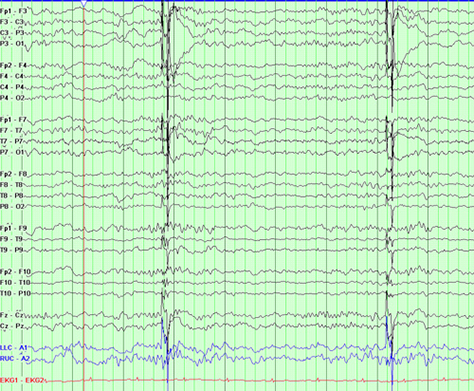
As you can see, the electrodes’ coverage is fairly broad. The researcher spreads electrodes and conductive gel all over the subject’s scalp to enable the EEG to read the electrical signals over as much of the brain as possible. The EEG can record fluctuations in the activation of the brain’s signals over a period of time. Figure 2 shows a readout of the raw data from an EEG machine. Each line represents the activity between two points on the scalp.

One scenario for EEG use could be testing human performance in face recognition. A clinician might show a patient a face and, based on the strength of the brain signals the patient exhibits, establish whether the area of the brain that is responsible for processing faces is faulty.
The stronger, or more polarized, a line appears in the EEG readout, the more powerful the person’s ability to process a stimulus. For example, when a person is processing an object, we might see a line representing one part of the brain drop down in the EEG readout. But when that person is shown a face, the line polarizes even further, showing that humans specialize in processing other people’s faces.
These tests have their foundation in previous research that established the area of the brain that is associated with processing faces. To determine whether a part of the brain is responsible for processing something, it is necessary to conduct tests repeatedly with various participants to ensure that the changes in polarization are not coincidental, but recognition of an established effect.
A headset that is designed to perform these sorts of tests could use up to 72 electrodes, allowing very broad coverage of the scalp. However, while these headsets are quite powerful, they aren’t the most portable of technologies.
How Has EEG Changed?
Manufacturers have refined EEG technology and made it more lightweight and flexible to appeal to the commercial market. Some companies have adapted EEG by removing electrodes and adding a built-in power supply, making an EEG a transportable and even wearable device. But the major trade-off for this flexibility is in sensitivity and adaptability. While a portable EEG doesn’t provide the range of measurement of a lab EEG, it is designed for very specific tasks. The most well-known application operates through the motor function—for example, moving an object like a wheelchair or a skateboard. The Gadget Show![]() recently demonstrated a skateboard controlled by using an EEG.
recently demonstrated a skateboard controlled by using an EEG.
Having placed electrodes on the areas of a person’s brain that are associated with movement, thinking about moving in a certain direction creates electrical signals that the headset picks up, and moves the person in the desired direction! This is one of the most concrete methods of implementing the use of EEG. However, other implementations of the technology outside the lab have often been of dubious value.
An ever-increasing number of studies have tried to establish whether an EEG is capable of measuring someone’s emotional engagement. While you might expect an EEG to be able to find the area of the brain that is responsible for emotion and engagement and, thus, help show emotional engagement—that is, Reading = Activation—you’d be wrong.
A journal articlePDF![]() reviewed 70 different studies that attempted to learn whether it is possible to definitively measure emotion and engagement using EEG. Guess what? You can’t. Not as successfully as you can with fMRI anyway.
reviewed 70 different studies that attempted to learn whether it is possible to definitively measure emotion and engagement using EEG. Guess what? You can’t. Not as successfully as you can with fMRI anyway.
EEG is not powerful enough to measure emotion and engagement reliably, even when using a full EEG cap. Reading emotion and engagement becomes even more of a gray area when using a commercial headset that measures brain activity using a limited number of electrodes.
